Editorial
This entry got written on the morning of the first of the month, so Happy April Fools! It's never been my policy to include deliberate misinformation in these pages, not even on that day of the year when it might be allowable. About as far as I'll go is resorting to the Terrible Pun—and yes, I know I don't usually need an excuse for that sin! Lower down is an item that gives a small preview of a design that is being done for publication in Model Engine Builder later this year: an engine suitable for the first time builder using desktop equipment like the Sherline. The name chosen for the engine is the tribute to the day, and even somewhat appropriate.
Australia's drought continues although forecasts are for some rain during April and May. At best this will slow the consumption of our last remaining water in the reservoirs. When dams that millions depend on fall below 20% capacity, any rain that would replenish them would cause serious flooding. The future is looking truly scary. Readers in the US are emailing me saying this situation confronting most of Australia gets no press there. I can understand that; there are states in the US with more population than our entire continent, so why look elsewhere for news items? But I do truly appreciate the concern expressed by people half the planet away who's only contact with me has been through these monthly musings. It will be a couple of years before we can get the water recycling plants on line. Even though this is the only practical solution, the crazies rant that this will cause the end of life as we know it, frightening the gullible by saying that drinking recycled water will cause birth deformities! They probably disapprove of noisy little model engines too. While we can, as some insist, drink beer instead, I would rather not have to bathe in it.
It seems like every month starts with an obituary. Yes, it's sad to report the passing of men who have made significant contributions to our hobby, but people die all the time; that's life. The majority are remembered only by those who know them personally. Those reported here are remembered with affection by countless numbers who never met them, but whose life has been touched by them in some way nevertheless. So I don't see the Vales as a downer; I see them as a reminder of what anyone can achieve through unselfish dedication. It's ok to be sad, but it's good to feel inspired as well.
Vale: Les Chenery (1931-2007)

Regular readers will certainly be aware of the scale and free-lance model engine designs by Les Chenery (England). I was saddened to hear that Les has passed away after a short illness on March 28, 2007. His son John wrote to say that despite difficult circumstances, Les remained lucid until the end and never lost his sense of humor. His plan sets and castings went to model builders all over the world. Les had caught the model engineering bug from his father at an early age. Like most, he built live steam models, but at some point, he developed a keen interest in internal combustion. After choosing a subject, he would spend countless hours in museums and archives studying, photographing and noting down details. Next came the required wooden patterns and castings. Then would start the long progression to design and build the rest of the engine. This process took many years involving much trial and tribulation. On completion of the engine, he would fine tune it and get it to run smoothly.
In addition to selling plan sets and castings, Les generously allowed Model Engineer and Engineering in Miniature to include them with construction series of his models that they published. All were very well received. His designs include:
Les liked rotaries. He built a 1/5 scale Bentley BR2 about the same time as Lew Blackmore gained fame for his 1/4 scale version. As well as his well known and reproduced Gnome rotary, he also built a nine cylinder le Rohne rotary and was developing a 14 cylinder, double bank Gnome rotary, plans for which did not reach the "ready for release" stage although photos appeared in the model press from time to time. Many of his models were entered in the Model Engineering Exhibition where he received recognition for his work in the form of many cups and trophies. These include:
- The Bradbury-Winter Cup
- The General Engineering Championship
- The Duke of Edinburgh Trophy
- Gold medal
- Silver medal
- Bronze medal (twice)
A special mention must be made of his long suffering wife Alice. She was his constant companion throughout his life and put up with his disappearance into his home workshop for the countless hours that his hobby necessitated. He was also ably assisted throughout the administrative side of his hobby by Alice who, due to the sheer number of phone calls that she answered, not only became very knowledgeable about the engines that Les made, but subsequently became good personal friends with numerous of his contacts' wives around the world!
Vale: Bill Wisniewski (1929-2007)

I know many of you—especially fans of K&B engines—will be saddened to hear the William (Bill) Wisniewski passed away quietly in his sleep early in March. Bill rose to prominence with his accomplishments in model engine design and successes in C/L speed at both the US National competitions and the FAI World Champ levels. He is credited with being the first to introduce the "pen-bladder fuel tank", development of Schnuerle ported engines for competition and production, and being the first to develop successful tuned pipes for model engines. He joined K&B as an engine designer in the 1960's and was responsible for most all of their racing engines. The AMA website has a brief Biography which lists some of his achievements, taken from the North American Speed Society's newsletter, Speed Times. A longer, more personal memorial to Bill appeared on the microair.info website. This site also has a photographic tour of his workshop, circa 1966 and a reproduction of his March 1967 article for Model Airplane News which effectively introduced the tuned pipe to the model engine world, plus an earlier MAN piece on The First Successful Pipe from former MAN "Round & Round" columnist.
Chenery Gnome
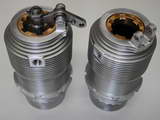
The Chenery Gnome is an ambitious project, but one that has been tackled successfully by many model engineers. Most are content to mount it on a stand and run it occasionally as a demonstration. Not so Ray Williams (central NY, USA). The completed engine was mounted in a scratch-built Avro 504K and flown! This photo of his cylinders shows subtle evidence of a true master craftsman. Look at the cooling fins that intersect the sparkplug boss and rocker posts. These can't be turned, they have to be slit or milled. Try imagining how you might tackle that job and ask yourself if you could do half as good a job as Ray has—I doubt I could. Click here for construction photos and take note of the last photo in the sequence that gives an idea of not only the size of the engine, but the mass of the spinning engine and prop. This is an engine that deserves respect!
HEX-4
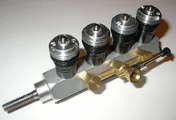
Remember the HEX-2? Well designer Jerry James felt that the concept could be extended a bit further. The HEX-2 incorporated an alternate-firing inlet valve in the crankshaft center spool by having no "shaft" section as such. Instead, what would normally be the crank web became the shaft enabling what is usually a complex assembly to be greatly simplified at the expense of extra friction due to the increased "shaft" surface area. Jerry's new design has three such spools. The fore and aft ones provide the inlet valves to the front and rear pairs of cylinders. The centre one provides the isolation required to make the engine function as a pair of coupled, opposed firing twins. From an operational perspective, the engine presents mounting problems, is rather heavy, and will not develop the same power as the four Cox cylinders would as single cylinder units, but that is not the objective. The HEX-4 is intended as a FUN project that can be built with minimal equipment. And even though, being Cox cylinder based, builders won't be able to say they made it all themselves, there is sufficient precision work involved to give constructors a true sense of achievement. Then there's the wonderful noise...
Where In The World Are You?

A new bell or perhaps whistle has been added to the very end of the editorial pages: a world map that shows the geographic location of visitors to the editorial page in the past 24 hours—or more accurately, the location registered for the domain that supplied the IP addresses. This is a rolling display, so the dots denoting locations will be continually appearing and dropping out. It's been active since mid-March and I've been looking at it periodically. Apart from the usual suspects in the USA and western Europe, I've seen repeated dots appearing in Iceland, Greenland, the western shore of Hudson Bay, some places in the mid Atlantic and Pacific that must be islands I didn't know existed, and even Tasmania! The IP geolocation resolution that gives the red dot is not 100% perfect, but it's good for most cases. Hope you have fun seeing how many other Model Engine News readers are clustered around you, or not, as the case may be.
Cams and Mice and things

Model Engineer's resident IC editor, Nemett, emailed with news that he has finished an all-new book on Miniature Internal Combustion Engines that he's been working on for a year or more. Even better, it will be published around the end of April 2007. In my humble opinion, this is terrific news. It confirms the feeling I have that more and more model engineers want to build 20th century technology rather than 19th. If other conformation is required, it demonstrates a publisher's faith that such a venture will provide the all important ROI. This book provides detailed information about the processes involved in constructing such engines, so that those with a basic knowledge of machining and workshop techniques will feel confident in building a simple single cylinder engine. It is not intended to be a detailed construction manual. Rather it describes the techniques involved in producing all the components required for an IC engine. Where possible, photographs of actual set-ups have been used to illustrate the setups used. A review copy will be sent to us (gotta love graft) and I'll pass on my unbiased view in due course. In the meantime, you can
pre-order it from Amazon (even if they don't have a picture yet
(even if they don't have a picture yet  ).
).
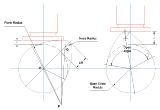 A by-product of Malcolm's mail—sorry, Nemett's mail—resulted in my trying the CamCalc lift table generator under the Firefox browser. This is now my standard browser for both Windows and Linux. Web site stats still show IE as top dog, accounting for about 70% of all hits. Firefox is next at about 25%, with others down in the noise. These numbers show that Firefox is a significant and rising force out there, so I was alarmed and ashamed to find the test result was a Big Zero (truly, the so-called Javascript language and what Microsoft did to make it non-portable is an abomination in the sight of ghods and men).
A by-product of Malcolm's mail—sorry, Nemett's mail—resulted in my trying the CamCalc lift table generator under the Firefox browser. This is now my standard browser for both Windows and Linux. Web site stats still show IE as top dog, accounting for about 70% of all hits. Firefox is next at about 25%, with others down in the noise. These numbers show that Firefox is a significant and rising force out there, so I was alarmed and ashamed to find the test result was a Big Zero (truly, the so-called Javascript language and what Microsoft did to make it non-portable is an abomination in the sight of ghods and men).
Any-hooo, it's now fixed and validated under IE6 and Firefox 2. I've managed to get it to run under IE7 as well, but—bless their little cotton socks—our friends at take-over-the-world central have inserted so many road-blocks that I can't say it will work first time for everyone. To be fair, mostly, it is the overwhelming popularity of Microsoft products that make them the prime target for sociopaths, thus requiring all the productivity-restricting features they add in an attempt to protect users, mostly... If you need cam milling lift data, run Internet Exploder 7, and can't get it to go, email me via the link at the bottom of the page and I'm sure I'll be able to help you sort it out. I also have a secret experimental page that will email the calculated data to you, but for a number of reasons, I'm reluctant to fully open that to public access. Again, if you need it, 'mail me.
Watzits and Whozits
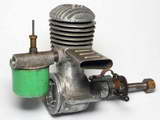
Which means we have new entries in the Watzit pages and in the Gallery pages. Aficionados of early British engines should recognize the Watzit. For the rest of us, a full description is provided. As well as being a fine collection, the gallery entry exemplifies focused model engine collecting. While the engines are relatively uncommon, there are still enough remaining to keep the owner, Steven Satkiewicz, hovering on the brink of divorce for many years yet.
Bar Humbug

Scuse' me Mr Scrooge, should that not be Bah Humbug? Such might normally be the case Cratchit, but not when the object in question is a 1.5cc model engine made from bar-stock! The idea behind this design is a beginners' engine designed to incorporate all the things which I think I've discovered by investigating other engines for the first-time builder. The design can be built for glow or diesel ignition, with rear-rotary or reed valve induction. All options are also convertible and interchangable—astute observers will note that the photo is a composite, not two separate engines.

There will also be a Custom Humbug that uses castings and for fun, has a Reuleaux head. This shot shows the internals from the prototype dropped into castings from Roger Schroeder. The engine is still evolving, but you can expect to see it in Model Engine Builder later this year. And I can't let this one go without saying thanks, I think, to my friend Van for instantly inventing the awful, awful, pun-of-a-name. One day, he'll go too far...
But Wait, there's More...
During the past month, a number of pages have undergone revision for minor corrections and additions. I always come clean and confess the mistake when a page needs a factual correction, but minor ones—usually to improve readability go unremarked. To find the changes, don't forget the Site Map | Update Index page. There is one entry in there that will go into the Members' Only area next month, so in the words of Douglas Adams, this may be your Last Chance To See... and no, I'm not going to tell you what it is (hint: it's a how-to page).
New Books and Magazines This Month

Model Engine Builder #9 arrived in my physical mailbox on the same day that notice it was shipping arrived in my electronic mailbox. How's that for fast? The issue is designated "September/December 2006" and marks the last single digit issue. Toni and Mike Rehmus are certainly to be congratulated for their hard work, as are all the contributors. As you can see from the cover, this issue contains the plans for the HEX-2, predecessor to the HEX-4 mentioned earlier. Other articles include a neat spindexer for 5C collets designed by Bruce Satra that can be made in the shop and would be a truly great gadget for porting cylinders. Although designed for use in a mill vise, it looks like it could be made to bolt direct to the lathe cross slide so that it is automatically and precisely on lathe center height (like the George H Thomas Universal Dividing Head). Other articles include more on how Brian Perkins fabricates complex parts for his scale engines, some information of work being done by Lee Hodgson in preparation for his 1/4 scale 18 cylinder Bristol Hercules sleeve valve engine, an unusual Kiwi "pivotal" engine described by Ron Cairns, and a funny little gadget for raising a bead in small diameter tubes by some bloke named Chernich.
-oOo-
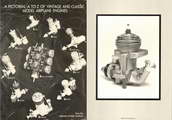
I keep mentioning Mike Clanford's A-Z, so it's way past time that it got the review treatment. This book first appeared in 1987 and became an instant treasure as it was the first such work published since the 1960's and provided the best overall coverage ever. The full name is A Pictorial A to Z of Vintage and Classic Model Airplane Engines, but it is generally just called Clanford's after it's sometimes controversial editor, Mike Clanford. It is soft bound with 218 pages printed in black and white on high quality, glossy paper. The ISBN is 0-9512524-0-2 and the publisher is given as Clan Enterprises of Surrey, England. The book is long out of print, but can still occasionally be found, generally commanding a price in line with many of the rare engines depicted in its pages!
 Each page typically contains six pictures, sometimes less, occasionally more. The engines get only one picture each and appear to have been photographed, cropped with pinking shears, then laid out with a name and a few words of description. While these descriptions have come under justified criticism for being inaccurate or downright wrong, the book gets far more right than wrong. I can't seem to get a single issue of Model Engine News out without making a mistake or two, so we should not be too harsh on a work that describes over 1200 different engines for the occasional boo-boo (the "Taipan Tyro" in the example page here is not a Tyro, but a 1960 series 1.5; the actual Tyro is correctly pictured and identified on the next page). There are better books for specific markets such as Tim Dannel's AMEE, but the benefit in Clanford is the breadth of coverage: American, English, Australian, German, Russian, Japanese, etc, etc. There are holes, but that is to be expected. If you don't have one and have the opportunity to acquire one, don't hesitate. Like the subject matter itself, this book will continue to increase in value.
Each page typically contains six pictures, sometimes less, occasionally more. The engines get only one picture each and appear to have been photographed, cropped with pinking shears, then laid out with a name and a few words of description. While these descriptions have come under justified criticism for being inaccurate or downright wrong, the book gets far more right than wrong. I can't seem to get a single issue of Model Engine News out without making a mistake or two, so we should not be too harsh on a work that describes over 1200 different engines for the occasional boo-boo (the "Taipan Tyro" in the example page here is not a Tyro, but a 1960 series 1.5; the actual Tyro is correctly pictured and identified on the next page). There are better books for specific markets such as Tim Dannel's AMEE, but the benefit in Clanford is the breadth of coverage: American, English, Australian, German, Russian, Japanese, etc, etc. There are holes, but that is to be expected. If you don't have one and have the opportunity to acquire one, don't hesitate. Like the subject matter itself, this book will continue to increase in value.
-oOo-

But wait, there's more... Issue #123 of the Model Engineer's Workshop arrived last month as well. MEW comes from the same stable as the Model Engineer and focuses on tools and techniques, freeing her older brother to deal with the making of models, mostly. I don't often mention MEW unless it contains something that seems of worth to model engine makers—as this one does, specifically an ER32 series collet chuck for the Myford 7 series lathes. The design, by regular contributor, Harold Hall, could readily be adapted to any small lathe unable to accommodate the now readily and cheaply available #3 Morse taper ER32 collet holder. I won't be making one as I've already made one that is almost identical to Harold's design. There is no rocket science (nor rocket engineering) in the design, although the article goes a good job of describing what is important in making such a chuck, what is not so important, and how to get the important bits right to ensure repeatable concentricity. See this month's tech tip for more details.
Engine Of The Month: Johnson J-BB 36
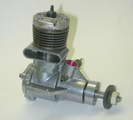
This month we look at the engines manufactured by Hi Johnson's Dynamic Models Inc between 1955 and 1963 with special focus on the twin ball race version. This is another of those cases where I thought to myself, "this will be an easy one; take a couple of photos, bash out a few words..." When am I going to learn? As I started typing, an obvious connection popped up between this top-end of the market engine and a low-end engine. None of the references in The Library make this connection, so either I'm the first to raise this, or I'm completely wrong. The review, now quite long, presents the evidence. Click the thumbnail, or this link and decide for yourself. There's a related engine in The Engine Finder too: check the new entries.
Tech Tip of the Month
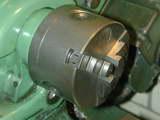
The three-jaw, self-centering chuck is quick and easy to use, but suffers from a couple of drawbacks when used for certain model engine making operations. First it exerts all of its holding force in three relatively narrow bands. Unless some protective shim is used, this force will mark a finished surface like a crankshaft journal. Applied to thin tubes like cylinders, it will distort the shape out of round. If you bore it in this condition, when released from the chuck the cylinder will spring back leaving you with a three-lobe bore. Lastly, the scroll actuated jaws do not provide very good repeatability unless you take care to replace the work in the same orientation and use the same scroll socket to tighten the chuck. And if there is any swarf particles in the scroll—as there usually is—just forget repeatability; you'll be lucky to do better than 0.005"
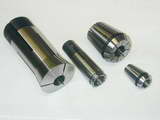 Collets cure all these problems. They apply clamping pressure over the entire diameter, so don't distort things out of round, nor produce localized forces that mark finished surfaces. They also grip tighter due to the greater contact area, and can provide exceptional repeatability. The downside is they are expensive and require special holders which may not be available to fit the sort of lathe found in our home work shops. The photo shows three styles, all with a nominal capacity of 1/2". From left to right they are R8, Myford 2MT pattern, and two representatives of the "ER" family. The first two are very good at holding stock of the nominal size, but as they close at the tip only, holding stock below the nominal size is less good and may require tailstock support to correctly align the work.
Collets cure all these problems. They apply clamping pressure over the entire diameter, so don't distort things out of round, nor produce localized forces that mark finished surfaces. They also grip tighter due to the greater contact area, and can provide exceptional repeatability. The downside is they are expensive and require special holders which may not be available to fit the sort of lathe found in our home work shops. The photo shows three styles, all with a nominal capacity of 1/2". From left to right they are R8, Myford 2MT pattern, and two representatives of the "ER" family. The first two are very good at holding stock of the nominal size, but as they close at the tip only, holding stock below the nominal size is less good and may require tailstock support to correctly align the work.
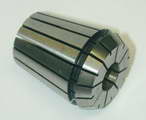 The ER series however is slit alternately from each end and the holder designed to apply closing force on the two tapers. This results in the collet closing parallel rather than cone shaped like the R8 and Myford style collets. ER series are available in a number of sizes which designate their major outside diameter in mm and hence, indirectly, the maximum size of work that can be held by the series. The table below gives the series types with the minimum and maximum work that can be held by a full set of collets in the series. The grip range of each collet is typically 1 mm.
The ER series however is slit alternately from each end and the holder designed to apply closing force on the two tapers. This results in the collet closing parallel rather than cone shaped like the R8 and Myford style collets. ER series are available in a number of sizes which designate their major outside diameter in mm and hence, indirectly, the maximum size of work that can be held by the series. The table below gives the series types with the minimum and maximum work that can be held by a full set of collets in the series. The grip range of each collet is typically 1 mm.
| Designation | Min (mm) | Max (mm) | Min (in) | Max (in) |
| ER8 | 0.5 | 5 | 0.02 | 0.20 |
| ER11 | 0.5 | 7 | 0.02 | 0.27 |
| ER16 | 0.5 | 10 | 0.02 | 0.39 |
| ER20 | 0.5 | 13 | 0.02 | 0.51 |
| ER25 | 0.5 | 16 | 0.02 | 0.63 |
| ER32 | 2 | 20 | 0.08 | 0.78 |
| ER40 | 3 | 30 | 0.12 | 1.18 |
| ER50 | 5 | 34 | 0.20 | 1.33 |
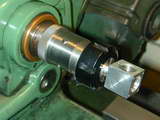 Here is my version of a shop made ER32 collet chuck for the Myford made about a year ago. As noted in the Harold Hall MEW article, the thread has been cut a bit "loose" so that the chuck will be aligned by the fit on the lathe spindle register. Taper turning for the collets was made in situ, so providing the chuck always goes back in the same place, repeatability should be excellent. The thread of the collet closer for the ER series is metric, as befits its orign. Like Harold, I decided to use a commercial closer rather than turn one as the inside incorporates an eccentric ring that snaps into the grove in the collet and acts to extract the collet from the taper as the nose is unscrewed. The thru-spindle capacity of the Myford is about 5/8" which I often find a bit limiting. For this reason, I made the chuck body a bit longer than what might be thought of as normal. This gives me just over 7/8" of effective spindle bore capacity for a couple of inches. The downside is a decrease in rigidity and an increased susceptibility to run-out error if the chuck does not align repeatably on the spindle register. The upside is being able to hold parts on their finish machined diameter with no danger of distorting nor marking, plus very high concentricity and an ability to remove the work and replace it with a precision close to between-centers repeatability.
Here is my version of a shop made ER32 collet chuck for the Myford made about a year ago. As noted in the Harold Hall MEW article, the thread has been cut a bit "loose" so that the chuck will be aligned by the fit on the lathe spindle register. Taper turning for the collets was made in situ, so providing the chuck always goes back in the same place, repeatability should be excellent. The thread of the collet closer for the ER series is metric, as befits its orign. Like Harold, I decided to use a commercial closer rather than turn one as the inside incorporates an eccentric ring that snaps into the grove in the collet and acts to extract the collet from the taper as the nose is unscrewed. The thru-spindle capacity of the Myford is about 5/8" which I often find a bit limiting. For this reason, I made the chuck body a bit longer than what might be thought of as normal. This gives me just over 7/8" of effective spindle bore capacity for a couple of inches. The downside is a decrease in rigidity and an increased susceptibility to run-out error if the chuck does not align repeatably on the spindle register. The upside is being able to hold parts on their finish machined diameter with no danger of distorting nor marking, plus very high concentricity and an ability to remove the work and replace it with a precision close to between-centers repeatability.
 Vale: Les Chenery
Vale: Les Chenery
 Vale: Bill Wisniewski
Vale: Bill Wisniewski
 Chenery Gnome
Chenery Gnome
 HEX-4
HEX-4
 Where In The World Are You?
Where In The World Are You?
 Cams and Mice and things
Cams and Mice and things
 Watzits and Whozits
Watzits and Whozits
 Bar Humbug
Bar Humbug
 But Wait, there's More...
But Wait, there's More...
 Editorial
Editorial
 New Books and Magazines This Month
New Books and Magazines This Month
 Engine Of The Month: Johnson J-BB 36
Engine Of The Month: Johnson J-BB 36
 Tech Tip of the Month
Tech Tip of the Month
 New and Updated Pages
New and Updated Pages
 Standard Stuff
Standard Stuff






 ).
).












